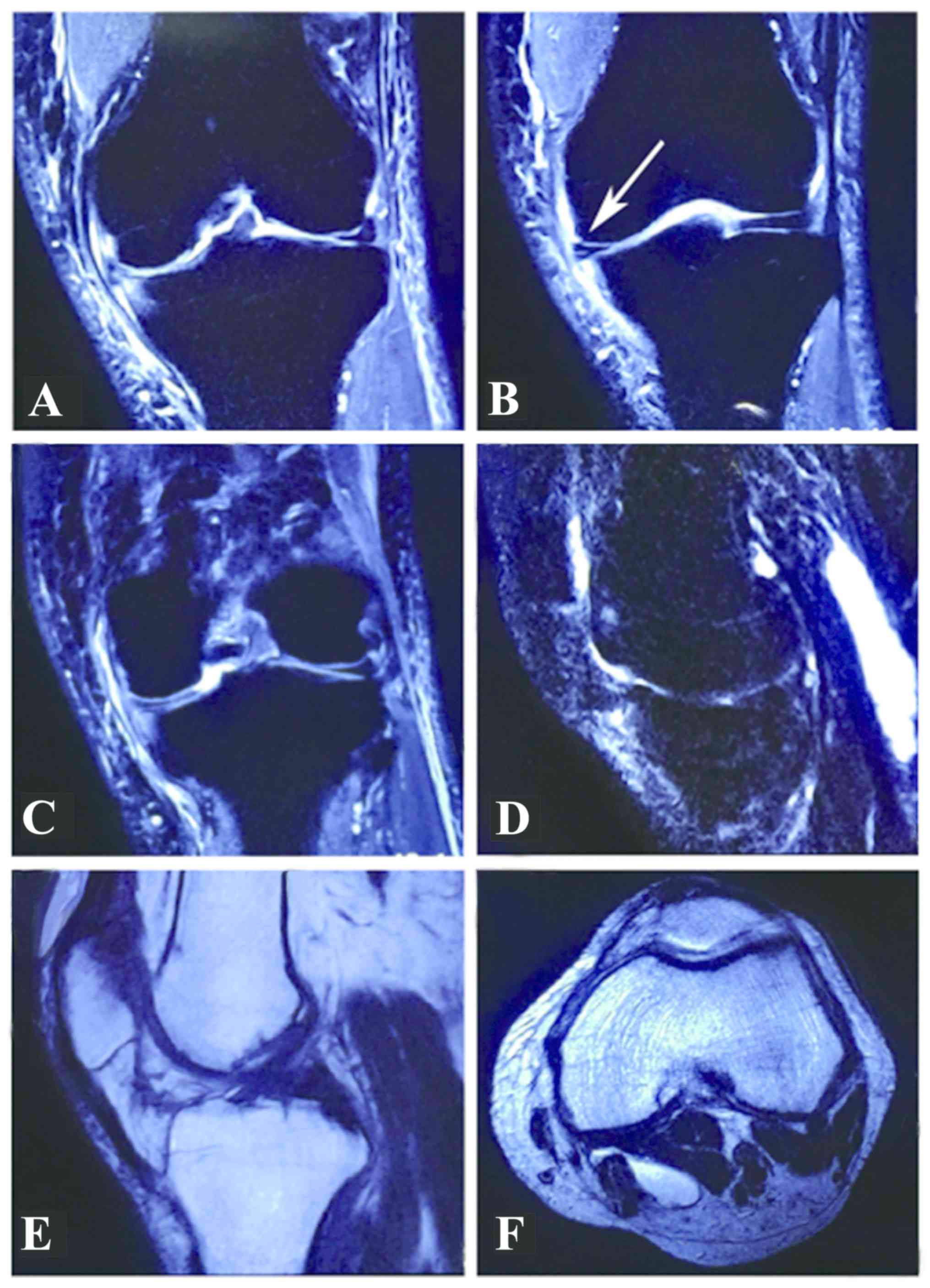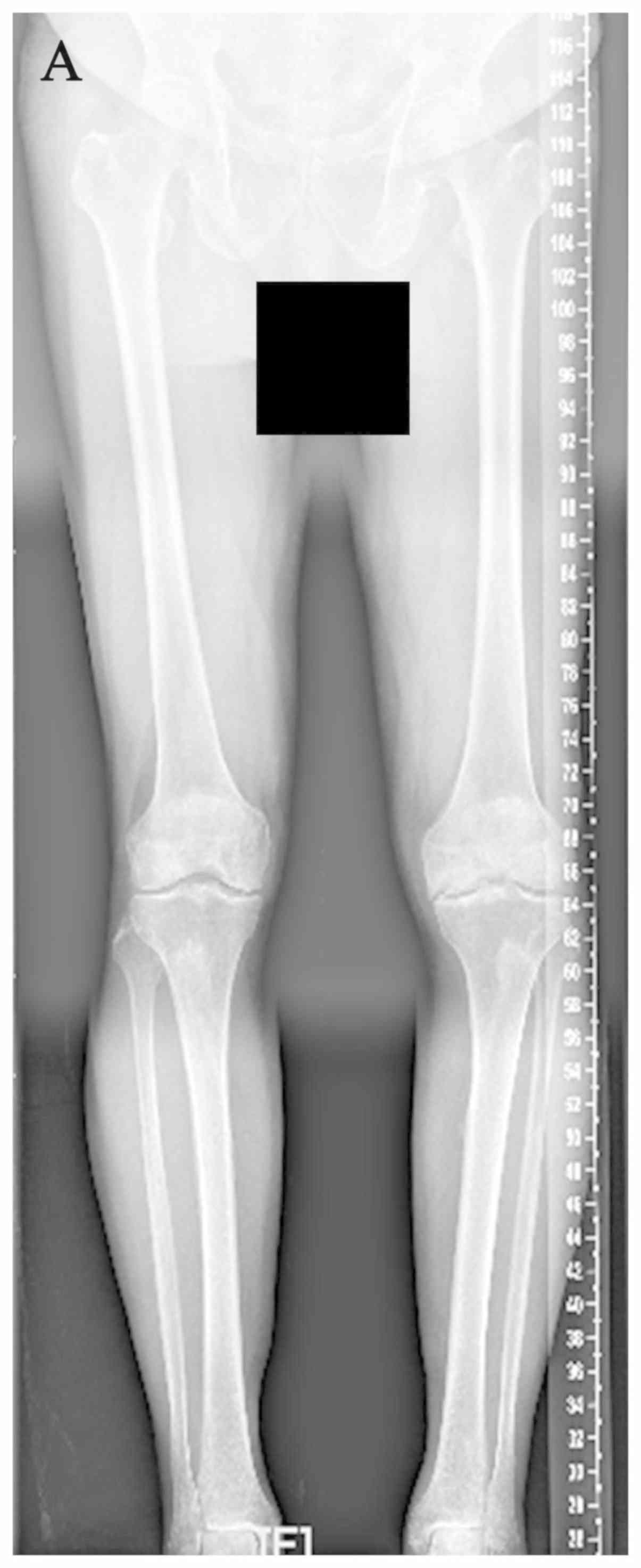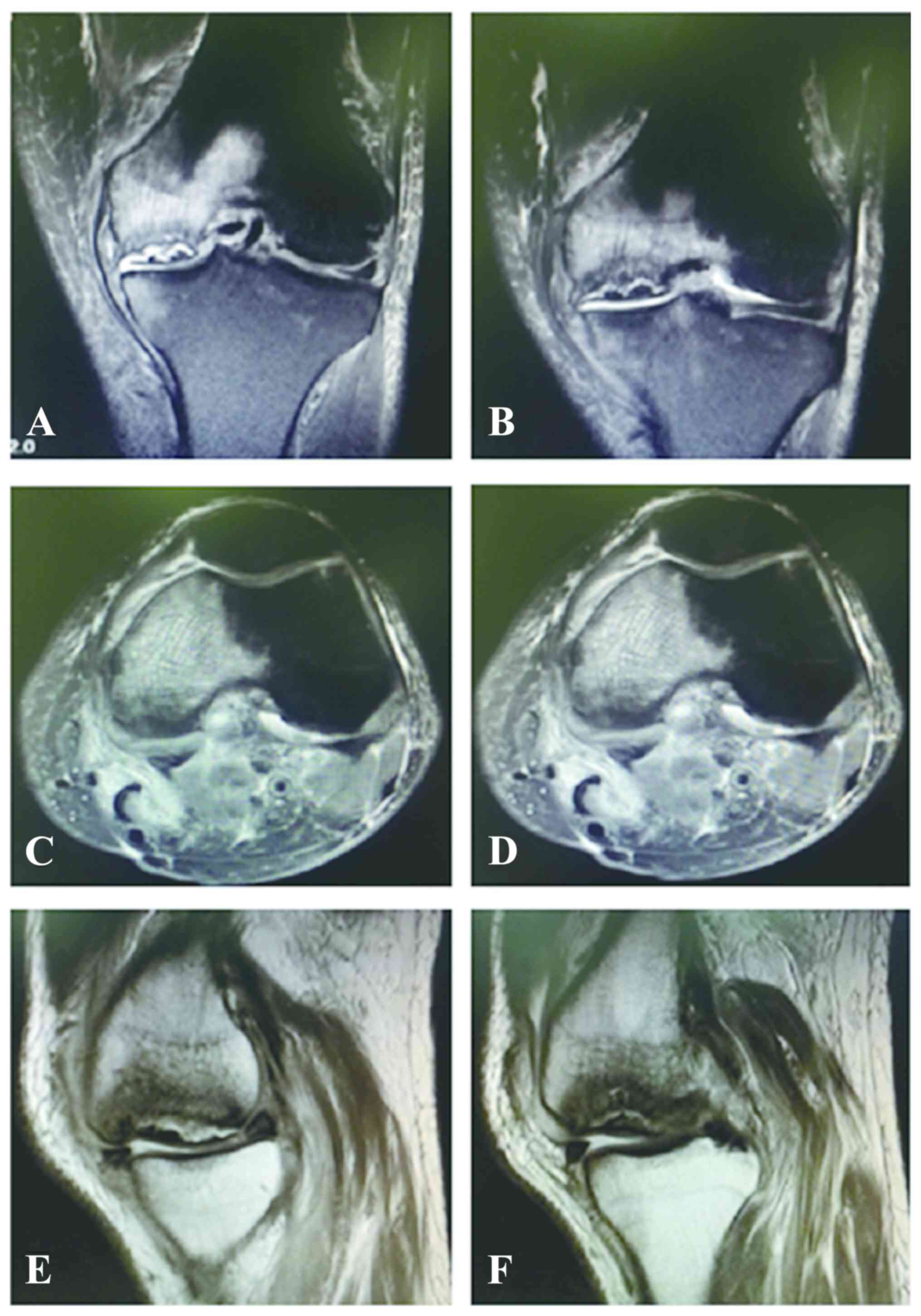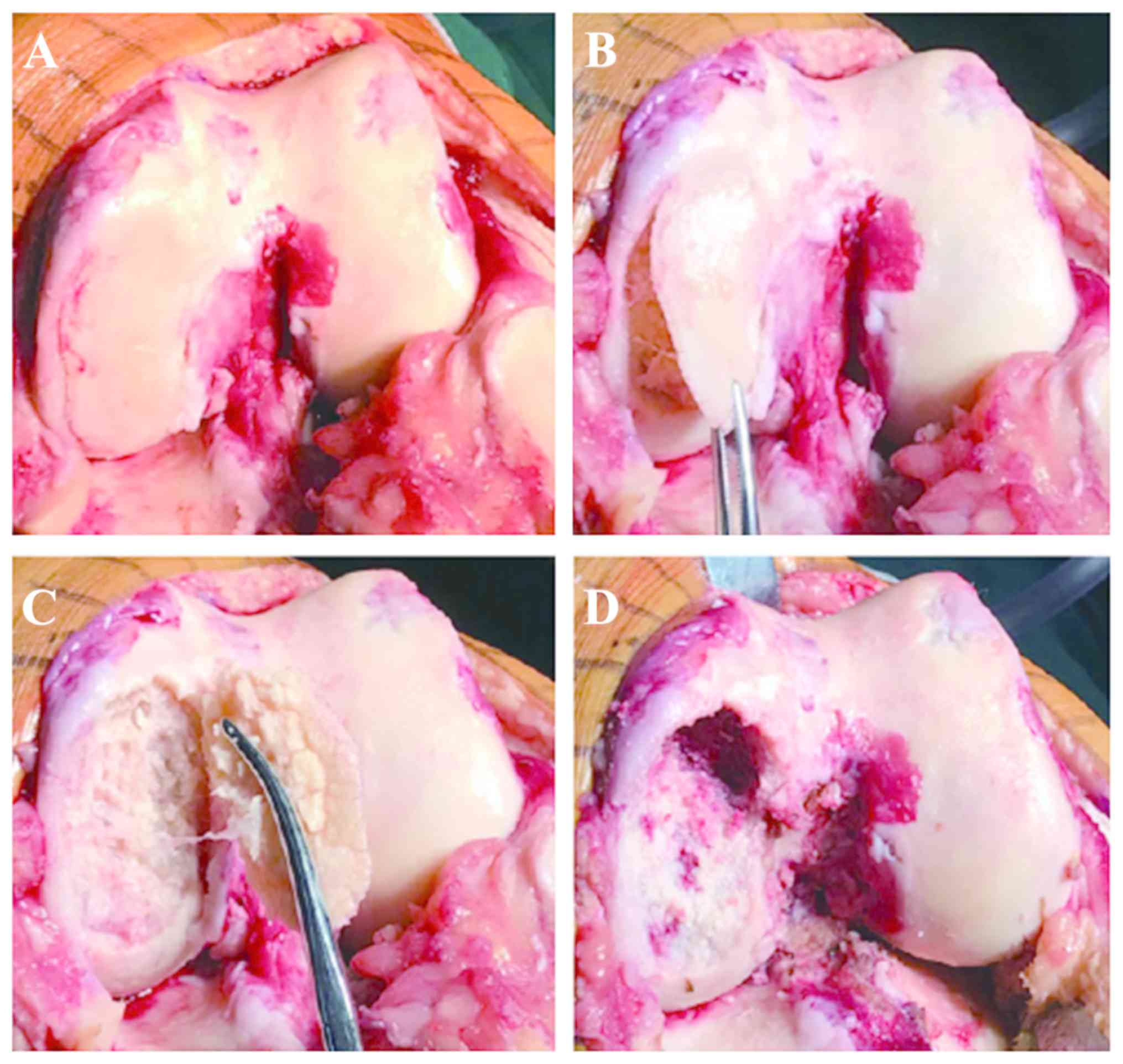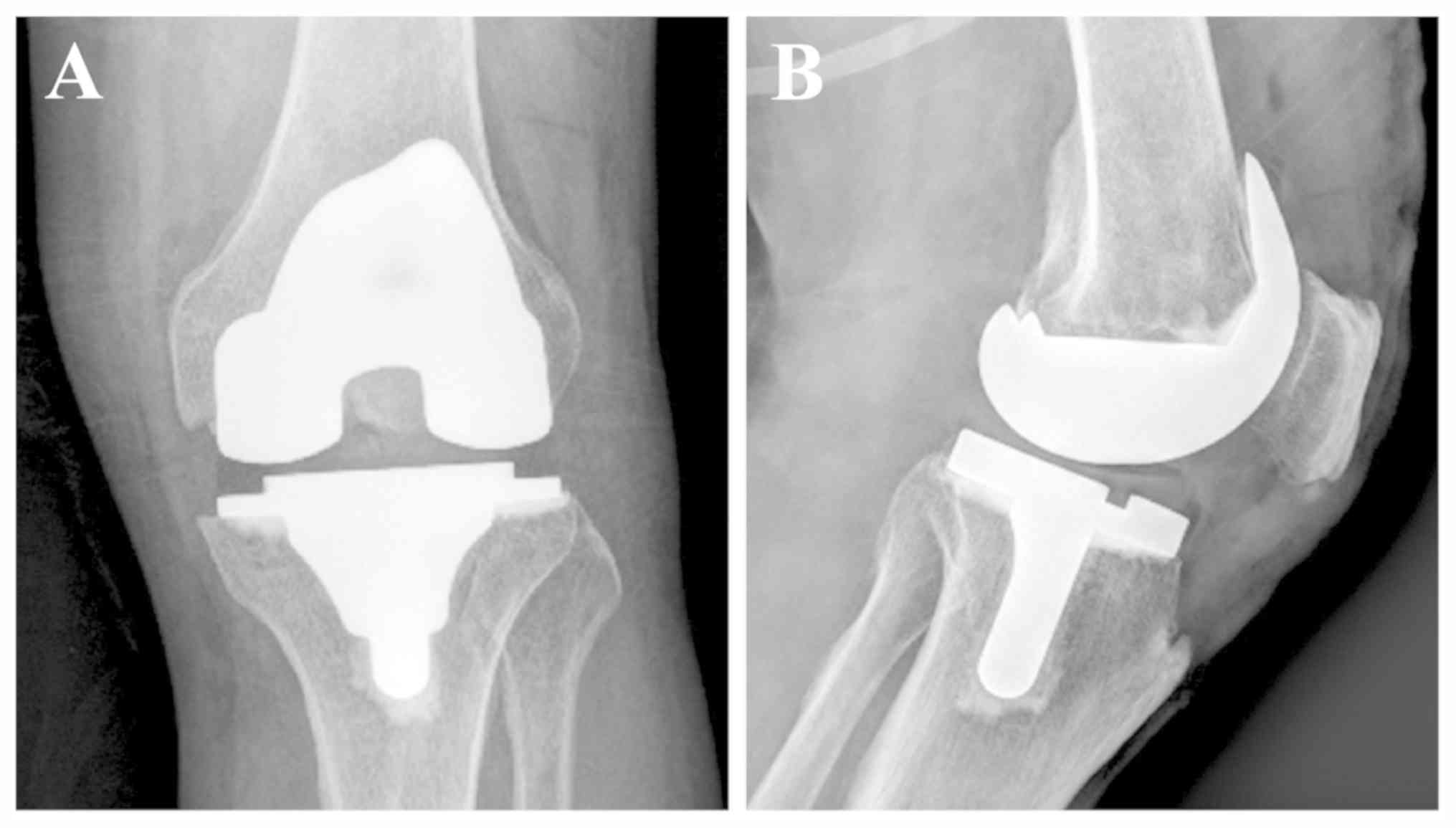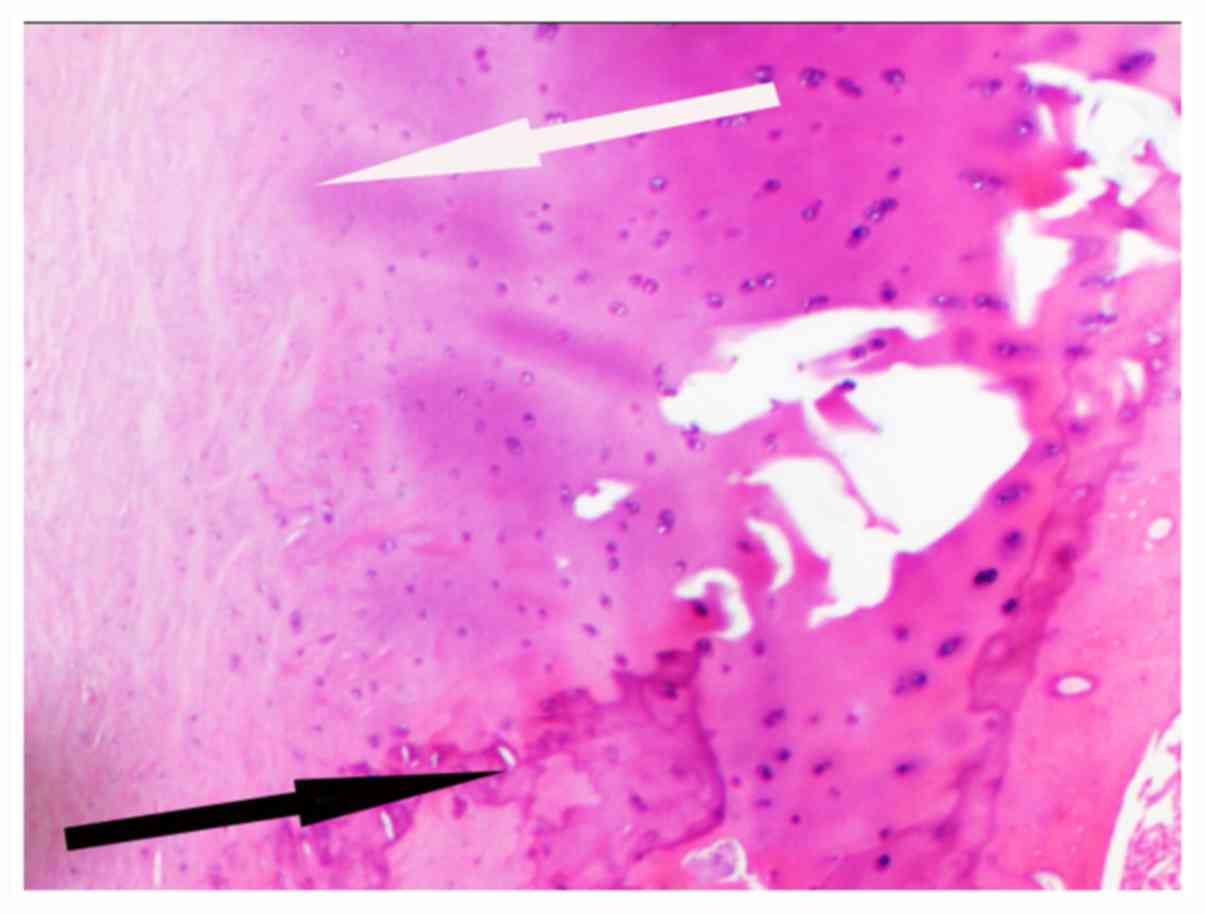|
1
|
Brahme SK, Fox JM, Ferkel RD, Friedman MJ,
Flannigan BD and Resnick DL: Osteonecrosis of the knee after
arthroscopic surgery: Diagnosis with MR imaging. Radiology.
178:851–853. 1991.PubMed/NCBI View Article : Google Scholar
|
|
2
|
Johnson TC, Evans JA, Gilley JA and DeLee
JC: Osteonecrosis of the knee after arthroscopic surgery for
meniscal tears and chondral lesions. Arthroscopy. 16:254–261.
2000.PubMed/NCBI View Article : Google Scholar
|
|
3
|
Faletti C, Robba T and de Petro P:
Postmeniscectomy osteonecrosis. Arthroscopy. 18:91–94.
2002.PubMed/NCBI View Article : Google Scholar
|
|
4
|
Kobayashi Y, Kimura M, Higuchi H, Terauchi
M, Shirakura K and Takagishi K: Juxta-articular bone marrow signal
changes on magnetic resonance imaging following arthroscopic
meniscectomy. Arthroscopy. 18:238–245. 2002.PubMed/NCBI View Article : Google Scholar
|
|
5
|
Patel DV, Breazeale NM, Behr CT, Warren
RF, Wickiewicz TL and O'Brien SJ: Osteonecrosis of the knee:
Current clinical concepts. Knee Surg Sports Traumatol Arthrosc.
6:2–11. 1998.PubMed/NCBI View Article : Google Scholar
|
|
6
|
Santori N, Condello V, Adriani E and
Mariani P: Osteonecrosis after arthroscopic medial meniscectomy.
Arthroscopy. 11:220–224. 1995.PubMed/NCBI View Article : Google Scholar
|
|
7
|
Pruès-Latour V, Bonvin JC and Fritschy D:
Nine cases of osteonecrosis in elderly patients following
arthroscopic meniscectomy. Knee Surg Sports Traumatol Arthrosc.
6:142–147. 1998.PubMed/NCBI View Article : Google Scholar
|
|
8
|
Garino JP, Lotke PA, Sapega AA, Reilly PJ
and Esterhai JL Jr: Osteonecrosis of the knee following
laser-assisted arthroscopic surgery: A report of six cases.
Arthroscopy. 11:467–474. 1995.PubMed/NCBI View Article : Google Scholar
|
|
9
|
Strauss EJ, Kang R, Bush-Joseph C and Bach
BR Jr: The diagnosis and management of spontaneous and
post-arthroscopy osteonecrosis of the knee. Bull NYU Hosp Jt Dis.
69:320–330. 2011.PubMed/NCBI
|
|
10
|
MacDessi SJ, Brophy RH, Bullough PG,
Windsor RE and Sculco TP: Subchondral fracture following
arthroscopic knee surgery: A series of eight cases. J Bone Joint
Surg Am. 90:1007–1012. 2008.PubMed/NCBI View Article : Google Scholar
|
|
11
|
Insall JN, Dorr LD, Scott RD and Scott WN:
Rationale of the Knee Society clinical rating system. Clin Orthop
Relat Res. 248:13–14. 1989.PubMed/NCBI
|
|
12
|
Petersen CL, Kjærsgaard JB, Kjærgaard N,
Jensen MU and Laursen MB: Thresholds for Oxford Knee Score after
total knee replacement surgery: A novel approach to post-operative
evaluation. J Orthop Surg Res. 12(89)2017.PubMed/NCBI View Article : Google Scholar
|
|
13
|
Ramkumar PN, Harris JD and Noble PC:
Patient-reported outcome measures after total knee arthroplasty: A
systematic review. Bone Joint Res. 4:120–127. 2015.PubMed/NCBI View Article : Google Scholar
|
|
14
|
Lansdown DA, Shaw J, Allen CR and Ma CB:
Osteonecrosis of the knee after anterior cruciate ligament
reconstruction a report of 5 cases. Orthop J Sports Med 24.
3(2325967115576120)2015.PubMed/NCBI View Article : Google Scholar
|
|
15
|
Hall FM: Osteonecrosis in the
postoperative knee. Radiology. 236:370–371; author reply 371.
2005.PubMed/NCBI View Article : Google Scholar
|
|
16
|
DeFalco RA, Ricci AR and Balduini FC:
Osteonecrosis of the knee after arthroscopic meniscectomy and
chondroplasty: A case report and literature review. Am J Sports
Med. 31:1013–1016. 2003.PubMed/NCBI View Article : Google Scholar
|
|
17
|
Son IJ, Kim MK, Kim JY and Kim JG:
Osteonecrosis of the knee after arthroscopic partial meniscectomy.
Knee Surg Relat Res. 25:150–154. 2013.PubMed/NCBI View Article : Google Scholar
|
|
18
|
Li L, Wang H, He Y, Si Y, Zhou H and Wang
X: Treatment of recurrent patellar dislocation via knee arthroscopy
combined with C-armfluoroscopy and reconstruction of the medial
patellofemoral ligament. Exp Ther Med. 15:5051–5057.
2018.PubMed/NCBI View Article : Google Scholar
|
|
19
|
Shi Y, Tian Z, Zhu L, Zeng J, Liu R and
Zhou J: Clinical efficacy of meniscus plasty under arthroscopy in
middle-aged and elderly patients with meniscus injury. Exp Ther
Med. 16:3089–3093. 2018.PubMed/NCBI View Article : Google Scholar
|
|
20
|
Bonutti PM, Seyler TM, Delanois RE,
McMahon M, McCarthy JC and Mont MA: Osteonecrosis of the knee after
laser or radiofrequency-assisted arthroscopy: Treatment with
minimally invasive knee arthroplasty. J Bone Joint Surg Am. 88
(Suppl 3):S69–S75. 2006.PubMed/NCBI View Article : Google Scholar
|
|
21
|
Cetik O, Cift H, Comert B and Cirpar M:
Risk of osteonecrosis of the femoral condyle after arthroscopic
chondroplasty using radiofrequency: A prospective clinical series.
Knee Surg Sports Traumatol Arthrosc. 17:24–29. 2009.PubMed/NCBI View Article : Google Scholar
|
|
22
|
Lotke PA, Ecker ML, Barth P and Lonner JH:
Subchondral magnetic resonance imaging changes in early
osteoarthrosis associated with tibial osteonecrosis. Arthroscopy.
16:76–81. 2000.PubMed/NCBI View Article : Google Scholar
|
|
23
|
Nakamura T, Matsumoto T, Nishino M, Tomita
K and Kadoya M: Early magnetic resonance imaging and histologic
findings in a model of femoral head necrosis. Clin Orthop Relat
Res. 68–72. 1997.PubMed/NCBI
|
|
24
|
Türker M, Çetik Ö, Çırpar M, Durusoy S and
Cömert B: Postarthroscopy osteonecrosis of the knee. Knee Surg
Sports Traumatol Arthrosc. 23:246–250. 2015.PubMed/NCBI View Article : Google Scholar
|
|
25
|
Karim AR, Cherian JJ, Jauregui JJ, Pierce
T and Mont MA: Osteonecrosis of the knee: Review. Ann Transl Med.
3(6)2015.PubMed/NCBI View Article : Google Scholar
|
|
26
|
Di Caprio F, Meringolo R, Navarra MA,
Mosca M and Ponziani L: Postarthroscopy Osteonecrosis of the Knee:
Current Concepts. Joints. 5:229–236. 2017.PubMed/NCBI View Article : Google Scholar
|
|
27
|
Pape D, Seil R, Anagnostakos K and Kohn D:
Postarthroscopic osteonecrosis of the knee. Arthroscopy.
23:428–438. 2007.PubMed/NCBI View Article : Google Scholar
|
|
28
|
Ficat RP: Idiopathic bone necrosis of the
femoral head. Early diagnosis and treatment. J Bone Joint Surg Br.
67:3–9. 1985.PubMed/NCBI
|
|
29
|
Mont MA, Marker DR, Zywiel MG and Carrino
JA: Osteonecrosis of the knee and related conditions. J Am Acad
Orthop Surg. 19:482–494. 2011.PubMed/NCBI View Article : Google Scholar
|
|
30
|
Kraenzlin ME, Graf C, Meier C, Kraenzlin C
and Friedrich NF: Possible beneficial effect of bisphosphonates in
osteonecrosis of the knee. Knee Surg Sports Traumatol Arthrosc.
18:1638–1644. 2010.PubMed/NCBI View Article : Google Scholar
|
|
31
|
Jacobs MA, Loeb PE and Hungerford DS: Core
decompression of the distal femur for avascular necrosis of the
knee. J Bone Joint Surg Br. 71:583–587. 1989.PubMed/NCBI
|
|
32
|
Duany NG, Zywiel MG, McGrath MS, Siddiqui
JA, Jones LC, Bonutti PM and Mont MA: Joint-preserving surgical
treatment of spontaneous osteonecrosis of the knee. Arch Orthop
Trauma Surg. 130:11–16. 2010.PubMed/NCBI View Article : Google Scholar
|
|
33
|
Tanaka Y, Mima H, Yonetani Y, Shiozaki Y,
Nakamura N and Horibe S: Histological evaluation of spontaneous
osteonecrosis of the medial femoral condyle and short-term clinical
results of osteochondral autografting: A case series. Knee.
16:130–113. 2009.PubMed/NCBI View Article : Google Scholar
|















